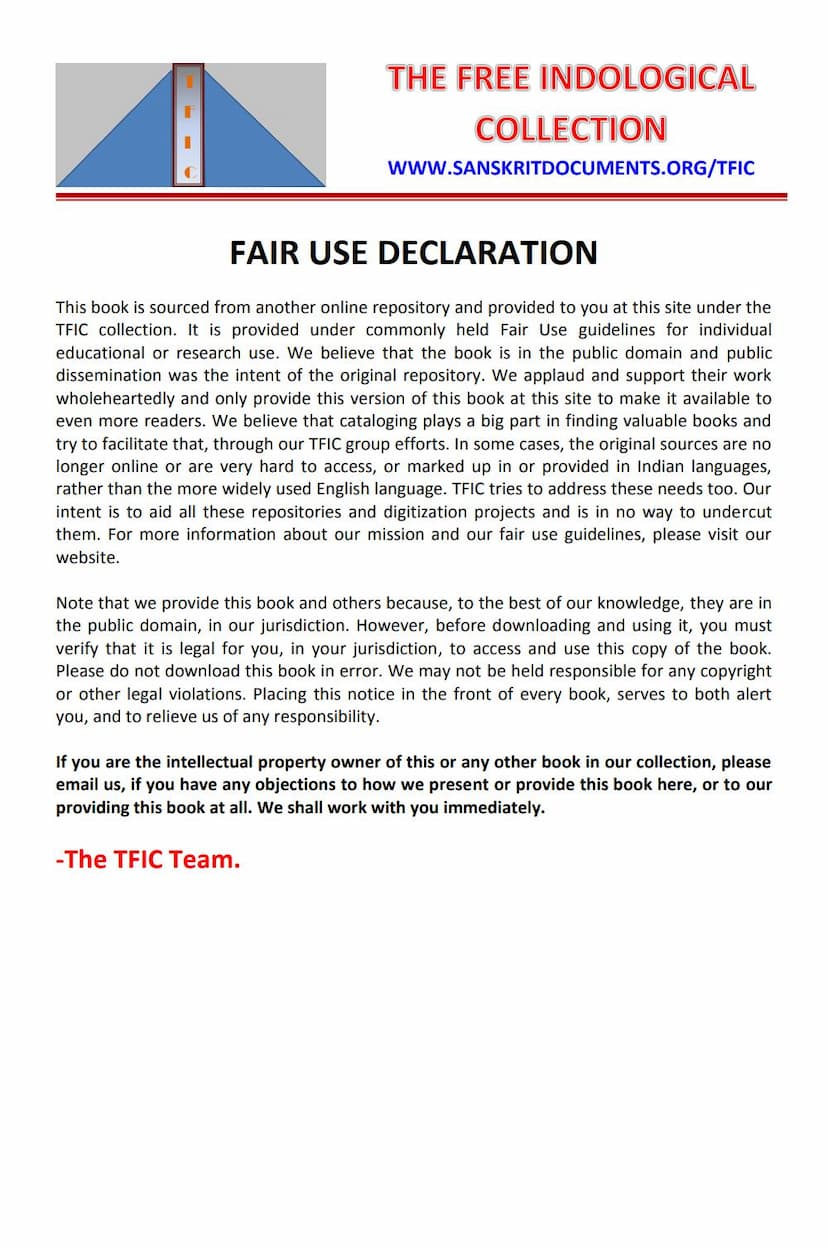Lavechu Digambar Jain Samaj
Added to library: September 2, 2025

Summary
This document is the book "Lavechu Digambar Jain Samaj" by Zammanlal Jain, published by Sohanlal Jain, Calcutta. The book aims to present the history of the Lavechu (also referred to as Lambakanchuk) Jain community and, in brief, other Jain communities.
Here's a summary of the key aspects and themes covered in the text:
-
Purpose and Justification for the Book: The author, Zammanlal Jain, a scholar of logic (Tarkateerth), states his intention to present a truthful and evidence-based history of the Lambakanchuk (Lavechu) community. He emphasizes that history should be supported by inscriptions, copper plates, oral testimonies from elders, Patawalis (genealogical records of religious leaders), government gazettes, and consistent oral traditions. He notes that this is an expanded second edition of a previously published, brief history of the community.
-
The Lavechu Community's Identity:
- Origin and Name: The book traces the origin of the Lavechu community to the Yadu dynasty, descendants of Lord Neminath and Krishna. The name "Lambakanchuk" is explained as meaning "one who wears a long coat of armor" or "one who wears a long protective garment," signifying bravery and warrior-like qualities. The current name "Lavechu" is presented as an evolved form of "Lambakanchuk."
- Connection to Lord Neminath and the Yadu Dynasty: A significant theme is the community's proud lineage from the Yadu dynasty, claiming descent from Lord Neminath, the 22nd Jain Tirthankara, and Lord Krishna. This connection is highlighted through scriptural references and eulogies.
- Lineage and Gotras: The text details the twelve primary sons of King Lomkarna (or Lambakarna) from whom twelve main Gotras (lineages) originated. These then branched out further, resulting in a total of eighty-four subdivisions. The book lists these Gotras and provides lineage details for several prominent ones like Sony, Bajaj, Raperia, Chandoria, Raut, Bakharia, etc.
-
Historical Evidence and Proof:
- Copper Plates and Inscriptions: A crucial part of the book involves presenting evidence from ancient copper plates and inscriptions found in temples in places like Allahabad (Prayag). These documents, dating back to the 15th and 16th centuries Vikram Samvat (14th-16th centuries CE), explicitly mention the "Lambakanchuka anvaya" (lineage), various Gotras (Soni, Budhele), and the names of individuals who commissioned or established these artifacts.
- Patawalis (Genealogical Records): The author refers to Patawalis from Surepur (Bateshwar), Gwalior, and other places, which list Jain Acharyas and their disciples, often mentioning the Gotras and lineages of those who sponsored their activities, further corroborating the community's ancient roots.
- Oral Traditions and Bardic Accounts: The author also relies on the oral traditions of the community and the historical accounts preserved by "Ray Bhats" (hereditary bards). These bards recount the lineage and deeds of prominent families.
- Place Names and Origins: The text connects various place names like Kanchangiri, Lawa (Lama), Surepur (Shauryapur), Bateshwar, Chandwar (Chandpat), Raperi, Bakhepur, Kudar Kot, etc., to the Lavechu community's history and migration patterns.
- Etymology and Language: The author delves into the etymology of names like "Lambakanchuk," "Lavechu," and various Gotra names, explaining their possible origins and evolution. He also discusses linguistic shifts, such as "Chahaman" evolving into "Chauhan," and "Lambakanchuk" into "Lavechu."
-
The Previous Edition and Corrections: The author mentions a previous, less detailed edition of the history. He criticizes the earlier publication for inaccuracies, such as mixing up Patawalis from different lineages, and expresses his intent to provide a more accurate and comprehensive account in this edition.
-
Manglesharan (Invocation) and Philosophical Basis: The book begins with a detailed mangalacharan (auspicious invocation) and philosophical discussion on the importance of respecting spiritual teachers (like Lord Arhant) and the concept of gratitude (कृतज्ञता). He argues that invoking the Arhant is essential for the success and well-being of any endeavor, unlike the perfunctory greetings found in non-Jain texts.
-
Community's Social Practices: The text touches upon certain social customs, such as the traditional greeting "Juharu" (जुहारू), which is linked to the warrior code and Kshatriya tradition. He notes its decline due to modern influences but emphasizes its significance in preserving community identity.
-
Historical Figures and Events:
- Lord Neminath's Birthplace: The text identifies Surepur (Bateshwar) as the birthplace of Lord Neminath and notes the close proximity of Lavechu Jain settlements to this sacred site.
- Community's Migration: The book discusses the migration of the Lavechu people from regions like Lawa (Kanchangiri) to Marwar and then eastward into the Antsved (Ganga-Yamuna Doab) region, settling in places like Etawah, Chanda war, Raperi, etc.
- The Role of Jain Acharyas: The Patawalis mentioned highlight the role of Jain Acharyas from the Moolsangh and specific Gachhas (lineages) in establishing and guiding the community, with Lavechu patrons often associated with these religious figures.
- The "Anuvrat Ratna Pradeep" (Apostolic Work): A significant portion of the book discusses a Jain Prakrit work titled "Anuvrat Ratna Pradeep," authored by Kavi Lakshman in the 13th century Vikram Samvat. This text details the life and teachings of Kavi Lakshman, his patron Kanhad, and the social and religious milieu of Chandwad. It also provides insights into Jain practices and philosophy.
-
The Author's Dedication and Hope: Zammanlal Jain expresses his hope that the readers will find the book informative and that it will inspire the community to uphold their heritage and strive for moral and educational upliftment. He also thanks individuals who supported his research and publication.
In essence, "Lavechu Digambar Jain Samaj" is a scholarly attempt to establish the historical identity, lineage, and social fabric of the Lavechu Jain community, drawing upon a wide range of historical and textual evidence, with a particular focus on their Yadu and Chauhan connections, and their adherence to Jain principles.